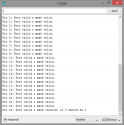Well.... I'm about to give up 
Started over again and tried multiple connections. First connection made 'normal' on the correct side:

That didn't work. When i connect the power, the LEDs blink shortly, that's it.
After that i tried to connect the other end of the Data, which also didn't work.
Then connected the power to the other end of the strip:

Also no joy. Now when i connect the power, the LEDs also don't blink.
The WS2812B have a Reversed Connection protection, so not sure if connecting the other end is useful, but i've tried it.
I've copied all files from the FastLED 2.1 repo into my library folder and using the following FirstLight sketch:
[hide]
[/hide]
I've tested the following 3 AddLeds options:
No joy I really have no clue what else to test.
I really have no clue what else to test.
The most logical problem would be that the data simply isn't read or something. Since the LED strip blinks when i connect power, i assume that's still good.
Assuming when the Arduino IDE says the code is uploaded, it should be good. During transfer is see the TX/RX LEDs light up, but never a response from the LEDs.
It could be possible that i have a 'faulty' Arduino, but then i would suspect the Basis Led blink stuff to fail also. Since that works fine (with the onboard LED), i'm assuming the data transfer to the arduino is working properly.
Started over again and tried multiple connections. First connection made 'normal' on the correct side:

That didn't work. When i connect the power, the LEDs blink shortly, that's it.
After that i tried to connect the other end of the Data, which also didn't work.
Then connected the power to the other end of the strip:

Also no joy. Now when i connect the power, the LEDs also don't blink.
The WS2812B have a Reversed Connection protection, so not sure if connecting the other end is useful, but i've tried it.
I've copied all files from the FastLED 2.1 repo into my library folder and using the following FirstLight sketch:
[hide]
Code:
// Use if you want to force the software SPI subsystem to be used for some reason (generally, you don't)
// #define FORCE_SOFTWARE_SPI
// Use if you want to force non-accelerated pin access (hint: you really don't, it breaks lots of things)
// #define FORCE_SOFTWARE_SPI
// #define FORCE_SOFTWARE_PINS
#include "FastLED.h"
///////////////////////////////////////////////////////////////////////////////////////////
//
// Move a white dot along the strip of leds. This program simply shows how to configure the leds,
// and then how to turn a single pixel white and then off, moving down the line of pixels.
//
// How many leds are in the strip?
#define NUM_LEDS 240
// Data pin that led data will be written out over
#define DATA_PIN 6
// Clock pin only needed for SPI based chipsets when not using hardware SPI
//#define CLOCK_PIN 8
// This is an array of leds. One item for each led in your strip.
CRGB leds[NUM_LEDS];
// This function sets up the ledsand tells the controller about them
void setup() {
// sanity check delay - allows reprogramming if accidently blowing power w/leds
delay(2000);
// Uncomment one of the following lines for your leds arrangement.
// FastLED.addLeds<TM1803, DATA_PIN, RGB>(leds, NUM_LEDS);
// FastLED.addLeds<TM1804, DATA_PIN, RGB>(leds, NUM_LEDS);
// FastLED.addLeds<TM1809, DATA_PIN, RGB>(leds, NUM_LEDS);
// FastLED.addLeds<WS2811, DATA_PIN, RGB>(leds, NUM_LEDS);
// FastLED.addLeds<WS2812, DATA_PIN, RGB>(leds, NUM_LEDS);
FastLED.addLeds<WS2812B, DATA_PIN, GRB>(leds, NUM_LEDS);
// FastLED.addLeds<NEOPIXEL, DATA_PIN, RGB>(leds, NUM_LEDS);
// FastLED.addLeds<WS2811_400, DATA_PIN, RGB>(leds, NUM_LEDS);
// FastLED.addLeds<GW6205, DATA_PIN, RGB>(leds, NUM_LEDS);
// FastLED.addLeds<GW6205_400, DATA_PIN, RGB>(leds, NUM_LEDS);
// FastLED.addLeds<UCS1903, DATA_PIN, RGB>(leds, NUM_LEDS);
// FastLED.addLeds<UCS1903B, DATA_PIN, RGB>(leds, NUM_LEDS);
// FastLED.addLeds<WS2801, RGB>(leds, NUM_LEDS);
// FastLED.addLeds<SM16716, RGB>(leds, NUM_LEDS);
// FastLED.addLeds<LPD8806, RGB>(leds, NUM_LEDS);
// FastLED.addLeds<P9813, RGB>(leds, NUM_LEDS);
// FastLED.addLeds<WS2801, DATA_PIN, CLOCK_PIN, RGB>(leds, NUM_LEDS);
// FastLED.addLeds<SM16716, DATA_PIN, CLOCK_PIN, RGB>(leds, NUM_LEDS);
// FastLED.addLeds<LPD8806, DATA_PIN, CLOCK_PIN, RGB>(leds, NUM_LEDS);
}
// This function runs over and over, and is where you do the magic to light
// your leds.
void loop() {
// Move a single white led
for(int whiteLed = 0; whiteLed < NUM_LEDS; whiteLed = whiteLed + 1) {
// Turn our current led on to white, then show the leds
leds[whiteLed] = CRGB::White;
// Show the leds (only one of which is set to white, from above)
FastLED.show();
// Wait a little bit
delay(100);
// Turn our current led back to black for the next loop around
leds[whiteLed] = CRGB::Black;
}
}I've tested the following 3 AddLeds options:
Code:
// FastLED.addLeds<WS2812, DATA_PIN, RGB>(leds, NUM_LEDS);
FastLED.addLeds<WS2812B, DATA_PIN, GRB>(leds, NUM_LEDS);
// FastLED.addLeds<NEOPIXEL, DATA_PIN, RGB>(leds, NUM_LEDS);No joy
The most logical problem would be that the data simply isn't read or something. Since the LED strip blinks when i connect power, i assume that's still good.
Assuming when the Arduino IDE says the code is uploaded, it should be good. During transfer is see the TX/RX LEDs light up, but never a response from the LEDs.
It could be possible that i have a 'faulty' Arduino, but then i would suspect the Basis Led blink stuff to fail also. Since that works fine (with the onboard LED), i'm assuming the data transfer to the arduino is working properly.

 Netherlands
Netherlands

